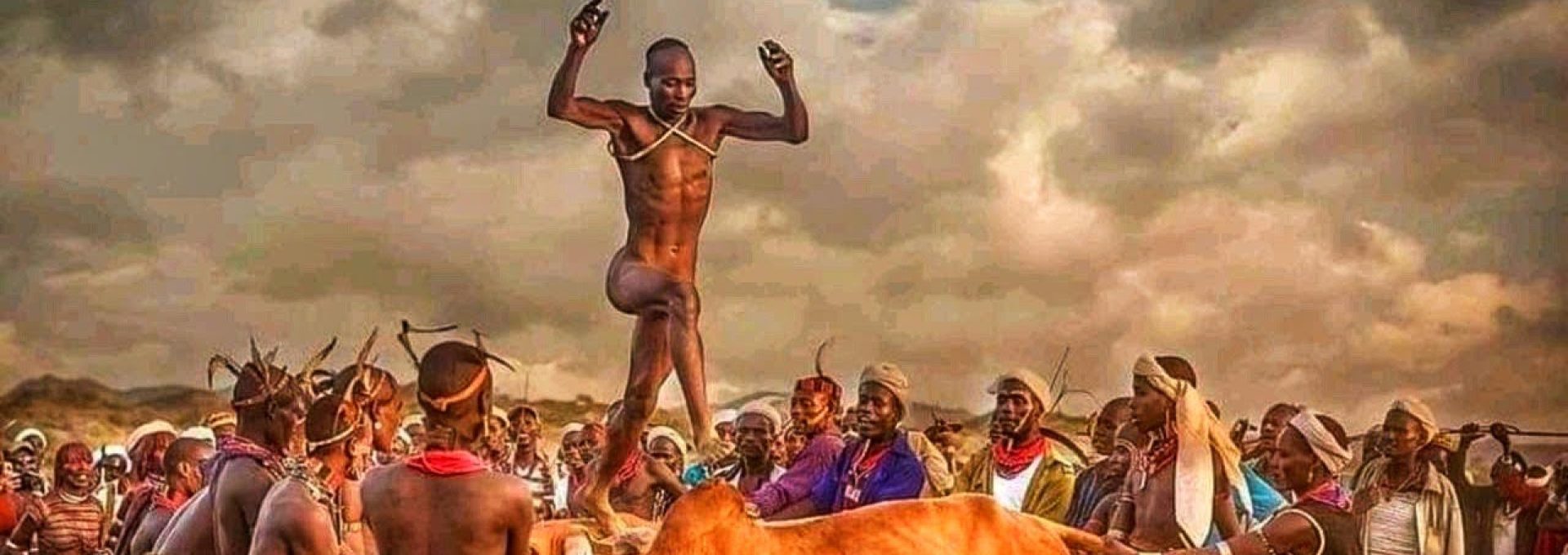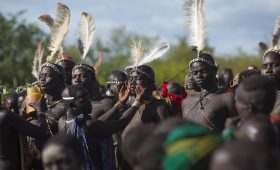A Glimpse Into One of Africa’s Most Powerful Traditions
Hidden deep in the heart of Ethiopia’s Omo Valley, the Hamer tribe practices one of the most visually stunning and emotionally charged ceremonies in Africa: the Bull Jumping Ceremony. This coming-of-age ritual marks a young man’s transition from boyhood to adulthood—and the moment he becomes eligible for marriage, land ownership, and greater responsibility within the tribe.
Steeped in symbolism, emotion, and community energy, the bull jumping ceremony is more than a spectacle—it’s a deeply rooted tradition that has remained largely unchanged for generations.
What Is the Bull Jumping Ceremony?
Known locally as “Ukuli Bula”, the bull jumping ceremony is an initiation rite performed by a young man (called the ukuli) who must prove his bravery and readiness for adulthood.
The climax of the ritual involves the young initiate running—naked and unaided—across the backs of a line of castrated bulls, usually four times back and forth. If he slips or falls, he must immediately try again and continue until he completes the task successfully on that same day. There is no postponement or second chance on another day—the ceremony must be completed in the moment. Only then is he recognized as a man by the tribe, marking his transition into adulthood.
The Ceremony Unfolds: A Cultural Experience in Full Color
The day of the ceremony is filled with vibrant dancing, singing, and traditional music, particularly led by Hamer women. These women—often sisters and relatives of the initiate— proudly encourage the ceremony with singing and rhythmic clapping, and even a controversial ritual of being willingly whipped to show loyalty and emotional connection to the initiate.
Though the whipping is difficult for many outsiders to witness, within the Hamer cultural context, it’s seen as an act of strength, love, and support. The scars left behind are carried with pride.
Preparations and Symbolism
Before the bull jumping begins, the family slaughters goats or cows for a feast, and elders perform blessings and ritual chants. The bulls are specially selected and smeared with dung to make them more difficult to run across—emphasizing the challenge and the courage required.
The initiate is usually covered in ashes, sacred soil, or local plant powders, representing purification and readiness to take on a new identity as a man.
When Does It Happen?
Unlike fixed festivals, bull jumping ceremonies are not scheduled far in advance. They usually occur after the harvest season, often from August to December, and are announced only about a week in advance by village elders. This makes witnessing one a matter of both timing and luck.
With a knowledgeable local guide—like those at Omo Region Tours—you’ll have the best chance to learn about upcoming ceremonies and attend respectfully if one is taking place during your visit.
How to Attend Respectfully
Attending a bull jumping ceremony is a privilege. It’s important to follow respectful etiquette: • Always ask for permission before taking photos
• Dress modestly and avoid standing in sacred spaces
• Be mindful of the emotional and cultural depth of the ceremony
• Support the community through local contributions or participation fees when requested
Why This Ceremony Matters
The Hamer bull jumping ceremony is more than a rite of passage—it is a symbol of resilience, community, identity, and connection to ancestral customs. For travelers, it’s a rare opportunity to witness living heritage in a raw and authentic setting, not re-created for tourism but practiced with the same purpose it has always held.
Experience It with Omo Region Tours
At Omo Region Tours, we specialize in authentic tribal experiences in Ethiopia’s Omo Valley, with a deep commitment to ethical travel and cultural preservation. Our expert local guides maintain strong relationships with tribal communities and will inform you if a bull jumping ceremony is likely during your visit.
Contact us today to plan your Omo Valley adventure and increase your chance of witnessing this extraordinary ritual.




